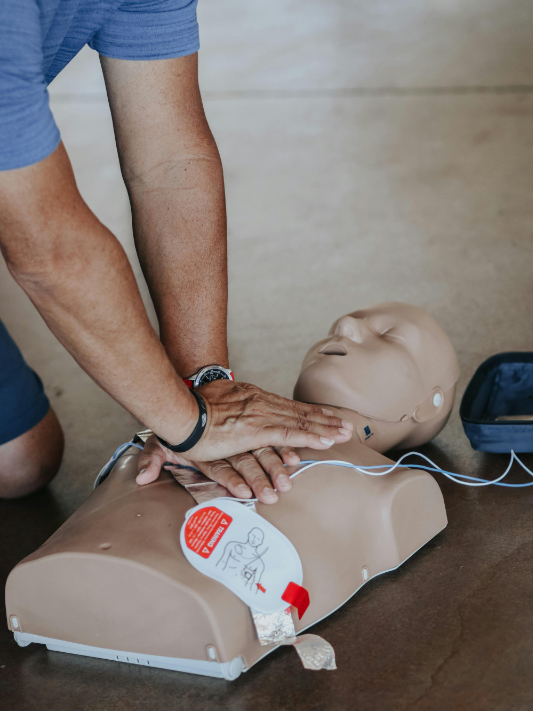Family Features - While many Americans agree Conventional CPR (cardiopulmonary resuscitation) or Hands-Only CPR (HOCPR) significantly improve a person's chance of survival from cardiac arrest, less than half are confident they can perform either Conventional CPR or HOCPR in an emergency.

Black or Hispanic adults who experience cardiac arrest outside a hospital setting are substantially less likely to receive lifesaving care from a bystander. In spite of these survey results, the American Heart Association is working to change this by empowering members of these communities to learn lifesaving CPR, and a growing segment of respondents are willing to act in an emergency. The American Heart Association's 2023 survey also revealed that as a result of the organization's efforts to change attitudes about performing CPR, which can lead to lifesaving results, more than half of African Americans said they would be willing to perform CPR in an emergency compared to 37% two years ago. Additionally, Hispanic and Latino respondents are more confident in their abilities to perform CPR. Committed to turning a nation of bystanders into lifesavers, the American Heart Association's multiyear initiative, Nation of Lifesavers, helps teens and adults learn how to perform CPR and use an automated external defibrillator (AED); share that knowledge with friends and family; and engage employers, policymakers, philanthropists and others to create support for a nation of lifesavers. "Each of us has the power in our own hands to respond to a sudden cardiac arrest," said Anezi Uzendu, M.D., American Heart Association expert volunteer. "We simply need to know what to do and have the confidence to act." The long-term goal: to ensure that in the face of a cardiac emergency, anyone, anywhere is prepared and empowered to perform CPR and become a vital link in the chain of survival, aiming to double the survival rate of cardiac arrest victims by 2030. It takes just 90 seconds to learn how to save a life using HOCPR, which can be equally as effective as traditional CPR in the first few minutes of cardiac arrest. Nationally supported by the Elevance Health Foundation, the American Heart Association's HOCPR campaign is focused on chest compression-only CPR. If a teen or adult suddenly collapses due to a cardiac event, you can take two steps to save a life: immediately call emergency services and use these tips to begin performing HOCPR. 1. Position yourself directly over the victim.
2. Put the heel of one hand in the center of the chest and put your other hand on top of the first.
3. Push hard and fast in the center of the chest at a rate of 100-120 beats per minute, which is about the same tempo as the song "Stayin' Alive" by the Bee Gees, and at a depth of approximately 2 inches.
4. Continue compressions and use an AED, if available, until emergency help arrives.
To learn more about how you could be the difference between life and death for someone experiencing a cardiac event, visit Heart.org/nation.

Photo by Raven Domingo/PEXELS
Black or Hispanic adults who experience cardiac arrest outside a hospital setting are substantially less likely to receive lifesaving care from a bystander. In spite of these survey results, the American Heart Association is working to change this by empowering members of these communities to learn lifesaving CPR, and a growing segment of respondents are willing to act in an emergency. The American Heart Association's 2023 survey also revealed that as a result of the organization's efforts to change attitudes about performing CPR, which can lead to lifesaving results, more than half of African Americans said they would be willing to perform CPR in an emergency compared to 37% two years ago. Additionally, Hispanic and Latino respondents are more confident in their abilities to perform CPR. Committed to turning a nation of bystanders into lifesavers, the American Heart Association's multiyear initiative, Nation of Lifesavers, helps teens and adults learn how to perform CPR and use an automated external defibrillator (AED); share that knowledge with friends and family; and engage employers, policymakers, philanthropists and others to create support for a nation of lifesavers. "Each of us has the power in our own hands to respond to a sudden cardiac arrest," said Anezi Uzendu, M.D., American Heart Association expert volunteer. "We simply need to know what to do and have the confidence to act." The long-term goal: to ensure that in the face of a cardiac emergency, anyone, anywhere is prepared and empowered to perform CPR and become a vital link in the chain of survival, aiming to double the survival rate of cardiac arrest victims by 2030. It takes just 90 seconds to learn how to save a life using HOCPR, which can be equally as effective as traditional CPR in the first few minutes of cardiac arrest. Nationally supported by the Elevance Health Foundation, the American Heart Association's HOCPR campaign is focused on chest compression-only CPR. If a teen or adult suddenly collapses due to a cardiac event, you can take two steps to save a life: immediately call emergency services and use these tips to begin performing HOCPR. 1. Position yourself directly over the victim.
2. Put the heel of one hand in the center of the chest and put your other hand on top of the first.
3. Push hard and fast in the center of the chest at a rate of 100-120 beats per minute, which is about the same tempo as the song "Stayin' Alive" by the Bee Gees, and at a depth of approximately 2 inches.
4. Continue compressions and use an AED, if available, until emergency help arrives.
To learn more about how you could be the difference between life and death for someone experiencing a cardiac event, visit Heart.org/nation.







